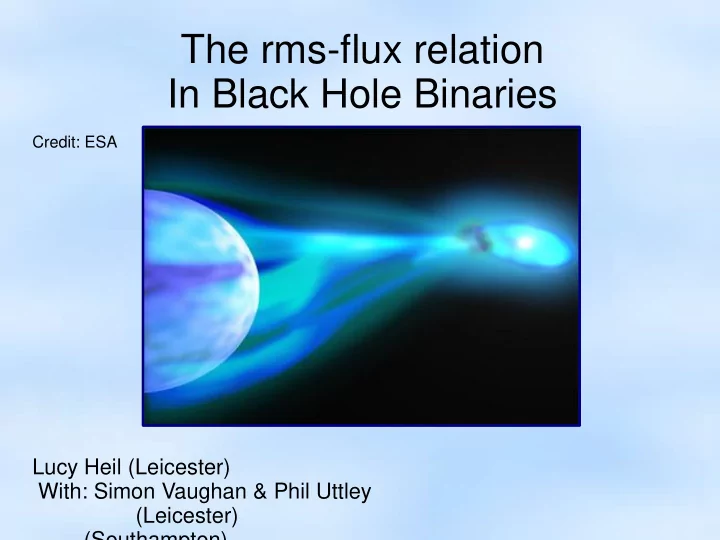

The rms-flux relation In Black Hole Binaries Credit: ESA Lucy Heil (Leicester) With: Simon Vaughan & Phil Uttley (Leicester) (Southampton)
The RMS-flux relation V4641 First identified in Uttley & McHardy (2001) XRB Cyg X-1 and NS SAX J1808.4-3658 Seen in - Selected observations in a few XRBs, NSs, AGN and a ULX Optically in XRBs Cyg X-1 studied in detail by Gleissner et.al. (2004)
Implications of rms-flux Puts shot to shot noise models?
Measuring the RMS-flux relation √ RMS values are binned to at least 20 points per bin
Good Observations XTE J1550-564 Most RXTE archival data for XTE J1118+480 GS 1354-64 4U 1543-475 k XTE J1550-564 XTE J1650-500 GRO J1655-40 GX 339-4 XTE J1859+226 C x H 1743-322 641 Good Observations
Ubiquity of the rms-flux relation GX 339-4 Apparently ubiquitous across all observations possible to process Caveats: Limited to observations above 3% fractional rms Excludes many soft state observations Observations with QPOs don't always behave themselves Sudden changes in power spectral shape exclude some observations
Intercept vs. Gradient RMS frac Green- Red 10% RMS frac
Negative X-intercepts? RMS A A B Mean Flux
Outburst Behaviour GRO J1655-40 XTE J1650-500 Hardness Green -> Blue -> Pink
Long-term behaviour
Conclusion RMS-flux relation appears to be ubiquitous for noise For stationary observations only Over both short and long terms Large number of observations with negative intercepts Extra components in light curve Results are consistent with Cygnus X-1 (Gleissner et. al. 2004). But extended to new states Analysis is still ongoing...
Mini-outburst of V4641
Identifying Good Observations Following criteria used: Kendall's tau > 0.5 Tau test > 2.0 σ X 2 test < 3.0 σ RMS frac > 3% Data outside this range but with RMS frac > 3% then investigated Good data needs: Long observation > 1 ks High count-rate > 100 ct/s/PCU High RMS frac > 3% good observations
Non-zero intercepts Suggest secondary component which does not obey the rms-flux relation Doesn't produce true linear relation Better to fit the variance – mean relation Parabolic however, and much harder to constrain
Recommend
More recommend